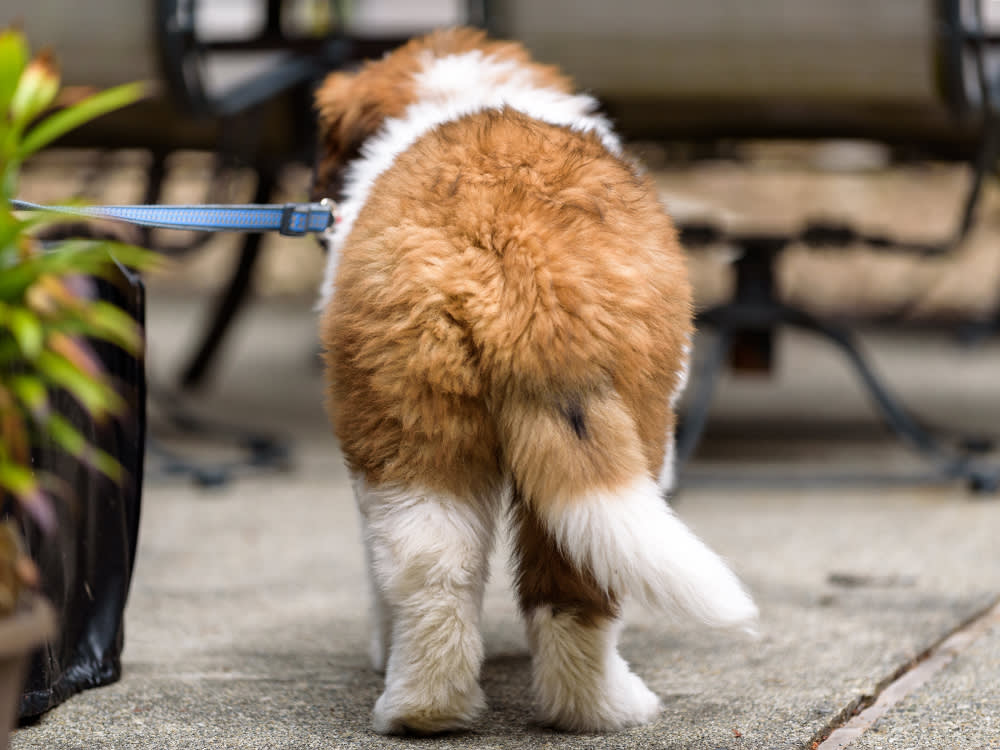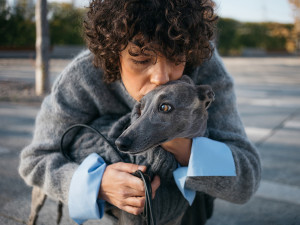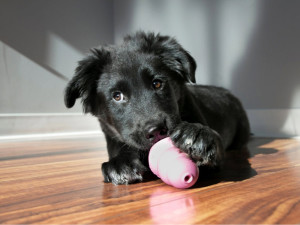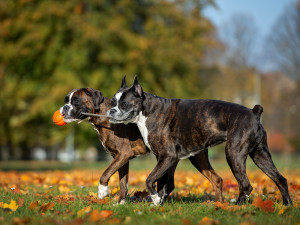How to Tell if Your Dog is a Lefty or a Righty
Your dog’s wag and paw preference say a lot about their personality.
You probably see your dog’s tail wag as a display of excitement, but did you know the movement can actually reveal a range of canine emotions? That’s why dog trainers and behaviorists (like myself) are constantly watching to see if a tail swings higher to the right or left — the asymmetrical motion indicates whether a dog is using the left or right hemisphere of their brain, which is a window into their emotions. But what about a dog’s dominant paw preference?
Yep, the idea behind this type of lateralization (preferring one side of the body over the other) extends far beyond matters of scissors and can-openers (people) and learning to shake (dogs). There are actually strong links between paw preference, the strength of that preference, and a dog’s behavior and emotional life. Let’s look at how a dog’s tail wag and dominant paw preference clue us into their personality and emotions.
Trick question: All dogs are perfect! But find out which type is the best fit for you.
Connecting Paw Preference and Your Dog's Emotions
A studyopens in new tab found that the direction of a dog’s tail wag depended on the stimuli. Dogs wagged higher to the right when greeting their humans; when they met unfamiliar people, the same right-side bias was seen — but at a lower angle. In response to cats, there was little wagging, but it was still higher to the right. The only stimulus that elicited a left-sided wag was an unfamiliar, confident dog. But why?
Asymmetrical tail wags reflect how the two sides of a dog’s brain process information and control their body. The right hemisphere reigns over the left side of the body, and the left hemisphere, the right side. So, for example, when dogs wag their tails to the right, they’re more intensely engaging muscles on the right side of their body, which means the left hemisphere is activated.
How much do you spend on your pet per year?
The left hemisphere is responsible for positive experiences and emotions including happiness, affection, and excitement, as well as anything familiar. The right hemisphere is in charge of processing sadness, fear, or other negative emotions and new things.
This link between emotions and sides of the brain originally came to light in studies of humans. One studyopens in new tab asked participants questions that elicited either positive or negative emotions, and they looked to their right (engaging the left brain hemisphere) in response to positive questions and to their left (engaging the right hemisphere) in response to negative questions. Similar lateralization — or a function’s localization to one side of the body — has since been found in fish, amphibians, reptiles, birds, primates and other mammals.
So, it makes sense that individuals — canine or human — who favor the left paw or hand use the right hemisphere of their brain more often, while right-pawed and right-handed individuals have a more active left-brain hemisphere. Studies have shown differences between right-pawed and left-pawed dogs. They have also revealed that dogs who are ambilateral — who don’t have a paw preference — are different in predictable ways from dogs who strongly prefer one paw over the other.
Is Your Dog a Righty or a Lefty?
In humans, we identify hand preference based on which hand a person uses to eat and write, or by seeing who keeps their arms tucked in tight when eating at a small round table. (It’s the lefties, because they’re used to colliding with the righties next to them.) In dogs, most determinations are based on the “Kong test,” in which dogs are observed extracting food from a Kong toy. Every time the dog uses a paw to stabilize the Kong, the observer records which paw is used. If the dog uses both paws simultaneously, that is also recorded, and all data is combined to determine paw preference and strength. There are approximately equal numbers of left-pawed, right-pawed, and ambilateral dogs, which is far different from humans, the majority of whom are righties.
Our dogs’ paw preferences provide insight beyond Kong play, though. One studyopens in new tab found that being right-pawed was associated with lower arousal and calmer responses to new experiences and strangers. Another studyopens in new tab found that dogs who were left-pawed exhibited more stranger-directed aggression than dogs who were either right-pawed or ambilateral. Many potential guide dogs fail their training — usually for behavioral reasons — and past researchopens in new tab has documented higher success rates of right-pawed than left-pawed dogs in training programs.
What Your Dog's Dominant Paw Preference May Mean
Paw preference alone has an affect on dogs’ emotions and behavior, but the preference’s strength also plays a part. For example, one studyopens in new tab demonstrated that dogs without a paw preference were more reactive to loud noises than dogs with a paw preference. Research has also shown that dogs with stronger paw preferences were bolder and less cautious than dogs with weaker paw preferences. They were also more confident, less prone to arousal and anxiety, quicker to relax or become playful in new environments, and exhibited calmer responses to new experiences and strangers.
It turns out that we humans are similar to our best friends in this regard: People with weak hand preferences are more likely to suffer high anxiety levels and are more susceptible to both PTSD and psychosis than those with a strong handedness.
And when it comes to guide dogs, just as being right-pawed predicted their training success, dogs with a strong lateralization (either left or right) and low rate of using both paws in the Kong test fared better. This may be because, according to researchopens in new tab, strongly lateralized and right-pawed dogs are less likely to experience high reactivity and distress responses — two requirements of a good guide dog.
In studiesopens in new tab of sensory processes and lateralization, dogs were simultaneously presented with identical stimuli on both their left and right sides while eating from a bowl. The direction they turned their heads indicated which side of the brain was involved in processing and responding to the stimulus, revealing the dogs’ emotional reaction to it.
In response to the social cues of canine isolation, disturbance calls, and play vocalizations, dogs consistently turned to the right (involving the emotionally positive left-brain hemisphere), but they tended to turn left (showing activation of the emotionally negative right-brain hemisphere) when they heard thunder.
Dogs also turned left in response to images of cats and snakes, but not to images of dogs. With repeated presentations, there was a change toward right-turning behavior, indicating that the left side of the brain and its associated positive emotions were involved. This suggests that novelty may be a factor in fear and other intense negative emotions that are processed by the right side of the brain.
These patterns aren’t limited to the head and paws, either. Other studies have revealed dogs’ nostrils role in processing — after all, the left and right nostrils are connected to their respective hemispheres. In one studyopens in new tab, dogs started to sniff new, but non-aversive stimuli (food, lemon, dog secretions) with their right nostril and then shifted with repetition to using their left nostril, showing a change from negative to positive emotions. When presented with adrenaline and sweat from their vets (yes, really!), they demonstrated a consistent bias toward the right nostril, suggesting that their emotions started and remained negative in response to these odors.
Why Your Dog's Paw Preference Matters
Our understanding of lateralization has potential to improve dogs’ quality of life, our relationships with them, and even our success in training them. We may be able to reduce stress by approaching dogs from their right side in exams, during greetings, or in any stressful situations. We can quickly see how dogs react emotionally to a variety of stimuli by paying attention to which way they turn, and we can observe the asymmetry in their tail wags to gauge their emotional state.
It’s possible that we can even minimize the development of noise phobias by placing dogs whose lateralization suggests vulnerability in quieter homes. We can minimize the substantial investment of time and money spent on training guide dogs by training only those who have the greatest chance of completing the program.
It’s all part of getting to know our dogs better, which breeds even more love for them (if that’s possible!). A dear dog friend of mine is strongly right-pawed; it was once pitiful to watch him attempt a left high-five, or use his left paw to hold his Kong when he briefly had a bandage on his right. I used to find his struggle somewhat comical. Now I understand that this trait is part of the package that makes him the unflappable, happy, playful, exploratory, unfazed kind of dog I love so much. I’m honored and overjoyed that when he greets me, his tail wags are as right-sided as the rest of him.






